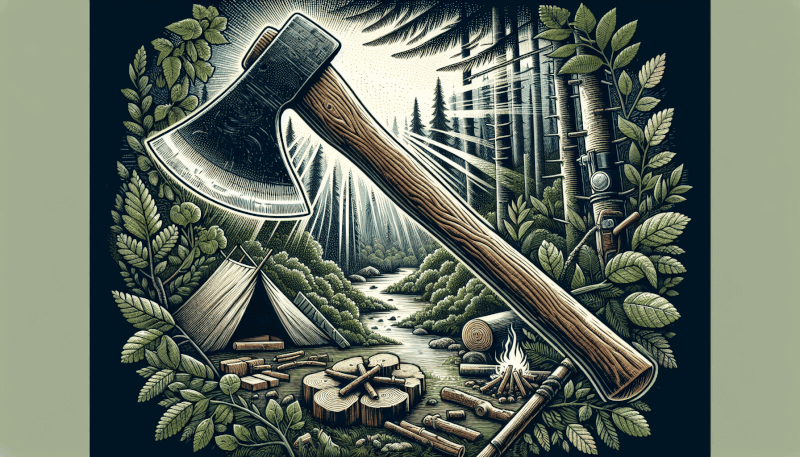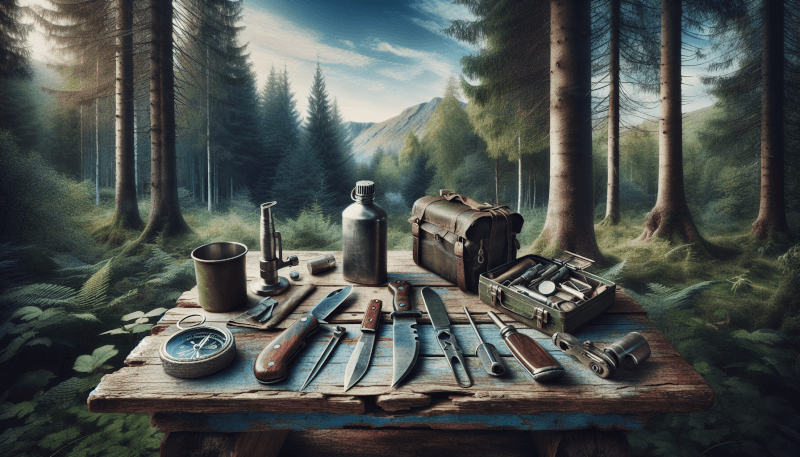Are you ready to embark on an adventure in the great outdoors? Look no further than the incredible world of bushcraft. This captivating article will provide you with an essential introduction to the art of survival in the wilderness, teaching you valuable skills and knowledge that are vital for anyone eager to explore nature’s untamed beauty. From building a shelter to starting a fire, you will discover the secrets of bushcraft that will not only enhance your outdoor experience but also ignite a newfound appreciation for nature’s wonders. So, grab your gear and get ready to immerse yourself in the thrilling world of essential bushcraft.
Shelter
Tarp Shelter
When it comes to survival in the wilderness, having a reliable shelter is crucial. One of the simplest and most versatile options is a tarp shelter. These lightweight and compact tarps provide excellent protection against rain, wind, and other elements. To set up a tarp shelter, start by finding a suitable location with sturdy trees or other anchor points. Then, string a paracord between the anchor points and drape the tarp over it. Use stakes or rocks to secure the corners and sides of the tarp, creating a protective canopy. Remember to angle the tarp to ensure proper drainage and allow for better ventilation.
Natural Shelters
In some situations, you may not have a tarp or other man-made materials available. It’s important to know how to utilize natural shelters to protect yourself from the elements. Look for natural formations such as caves, overhanging cliffs, or thick bushes that can provide a barrier against wind and rain. You can also create a makeshift shelter using branches, leaves, and other debris. Construct a lean-to structure by propping one end of a long, sturdy branch against a support, and use smaller branches and leaves to create a roof. Ensure that your shelter is well-insulated and elevated off the ground to avoid moisture and cold.
Firecraft
Fire Building
A fire is not only a great source of warmth but also essential for cooking food and purifying water. To build a fire, start by finding a suitable location away from overhanging trees or dry grass. Clear the area of any debris and create a fire pit to contain the flames. Gather tinder, such as dry leaves or small twigs, and create a small pile in the center of your fire pit. Surround the tinder with kindling, which is slightly thicker sticks, and finally, add larger logs as fuel. Use a match or a fire starter to ignite the tinder, gradually adding more fuel to build the fire.
Fire Safety
Fire safety is of utmost importance, especially in a survival situation where resources are limited. Always make sure your fire is fully extinguished before leaving it unattended. Pour water over the flames and stir the ashes to ensure no embers are left. Additionally, keep a safe distance from the fire and be mindful of loose clothing or other flammable materials. Clear a space around the fire to prevent accidental sparks from igniting nearby vegetation. Remember, fire can be a powerful tool, but it also requires responsible and cautious handling.
Fire Starting Methods
While matches or lighters may be readily available, it’s essential to have backup fire-starting methods in case they become lost or damaged. One reliable method is using a fire striker or ferro rod, which generates sparks when struck against a rough surface. Gather tinder and create a small nest to catch the sparks, then strike the ferro rod forcefully near the tinder to ignite it. Another method is friction fire-making, which involves using a bow drill or hand drill to create heat through friction. This technique requires practice and knowledge of suitable wood types, but it can be a valuable skill in dire situations.

Water Procurement
Finding Water Sources
In any survival situation, finding a source of water is vital to your survival. Keep in mind that not all water sources are safe to drink, so it’s crucial to know how to identify clean water. Look for moving water, such as streams or rivers, as it is generally less stagnant and more likely to be potable. If these sources are unavailable, consider collecting rainwater by using containers or creating a rainwater catchment system. You can also dig a shallow hole in moist soil or use vegetation to collect dew or extract water. Remember to avoid water sources near industrial areas and be cautious of potential contaminants.
Water Purification
Even if you find a water source, it’s essential to purify the water before consuming it. Boiling is one of the most effective methods of water purification. Simply bring the water to a rolling boil for at least one minute (longer at higher altitudes) to kill any harmful bacteria, parasites, or viruses. If boiling is not an option, you can use water filtration systems, water purification tablets, or liquid chlorine bleach to disinfect the water. Each method has its advantages and disadvantages, so it’s essential to be familiar with multiple purification techniques.
Water Storage
Once you have procured and purified water, it’s crucial to store it properly to prevent contamination and ensure its availability for future use. Carry water in clean, durable containers that are specifically designed for storing liquids. Opt for materials such as stainless steel or BPA-free plastic. Avoid containers that may leach harmful chemicals into the water, especially when exposed to heat. Store your water in a cool, dark place to prevent bacterial growth and maintain its quality. Remember to regularly check and replace stored water to avoid any potential deterioration.
Navigation
Using a Compass
Having a reliable navigation tool such as a compass is essential for finding your way in unfamiliar terrain. Begin by understanding the basic components of a compass, including the magnetic needle and the rotating compass housing. Familiarize yourself with the cardinal directions (north, south, east, and west) and how they correspond to the compass markings. To use a compass, hold it level and steady, allowing the needle to settle. Rotate the compass housing until the orienting arrow aligns with the needle, ensuring the direction of travel arrow points toward your destination. Once set, you can now use the compass as a reference to navigate accurately.
Map Reading
Alongside a compass, map reading is a crucial skill for effective navigation. Start by acquiring a detailed topographic map of the area you are in. Familiarize yourself with the symbols and markings used on the map, such as contour lines, roads, rivers, and landmarks. Understanding how to interpret the scale and grid references on the map is also important. Remember to orient your map using a compass to align it with the actual landscape. By combining compass reading skills with map interpretation, you will be able to navigate accurately and make informed decisions about your route.
Orienteering
Orienteering is a challenging yet rewarding outdoor activity that combines navigation skills with physical fitness. It involves completing a course by finding specific control points using only a compass and a map. By participating in orienteering exercises, you can further enhance your navigation abilities, spatial awareness, and decision-making skills. Orienteering courses can vary in length and difficulty, catering to beginners and experienced navigators alike. Engaging in this activity not only improves your survival skills but also provides an enjoyable way to explore and appreciate the natural environment.

Knot Tying
Basic Knots
Knowing how to tie essential knots is a fundamental skill that comes in handy in various survival situations. Start by learning versatile knots such as the square knot, which is useful for joining two ropes of equal diameter securely. The clove hitch is another valuable knot, often used to secure ropes to a pole or tree. Additionally, the figure-eight knot can be utilized to create a secure loop at the end of a rope. These basic knots form a foundation for more advanced techniques and can make a difference in constructing shelters, securing gear, or performing rescues in the wilderness.
Hitches
Hitches are knots that are specifically designed for attaching ropes to objects or other ropes. The taut-line hitch is an adjustable knot that is perfect for securing a line to a tent or tarp, allowing for easy tensioning. The trucker’s hitch provides a mechanical advantage, making it ideal for tightening loads or creating a stable anchor point. Familiarize yourself with various hitches as they can greatly assist in securing gear, building structures, or setting up traps in a survival situation.
Lashings
Lashings involve tying multiple poles or branches together to create more extensive structures. The tripod lashing is one of the most commonly used lashings and is perfect for creating a stable base for a shelter or signal mast. By overlapping the poles and using a series of tightly wrapped wraps and frapping turns, you can create a secure and robust structure. Mastering lashings enables you to utilize available resources effectively and construct more elaborate shelters, furniture, or tools when needed.
Toolcraft
Knife Skills
A knife is one of the most versatile and essential tools in a survival kit. Understanding and practicing proper knife handling skills is crucial for your safety and the efficient completion of tasks in the wilderness. Learn how to hold the knife securely, ensuring your fingers are away from the blade’s path. Practice various cutting techniques, such as slicing, chopping, and whittling, to improve your overall proficiency. Additionally, familiarize yourself with knife maintenance, including sharpening and keeping the blade clean and dry. With proper knife skills, you can process wood, create tinder, prepare food, and perform a range of essential tasks.
Axe Skills
An axe is a valuable tool for processing firewood, building structures, and crafting tools in the wilderness. However, it requires specific skills and techniques to ensure safe and effective use. Learn how to properly hold the axe using both hands, with one hand gripping below the head and the other further down the handle. Practice different axe swings, such as the horizontal and vertical swing, to split and shape wood effectively. Additionally, become familiar with techniques such as batoning, which involves using the back of the axe to split wood along the grain. With axe skills, you can efficiently process larger logs and create essential resources for survival.
Crafting Tools
In a survival situation, knowing how to craft tools from natural resources can greatly enhance your chances of survival. Learn to identify suitable materials such as bone, wood, or stone, which can be utilized to create various tools. Skills such as carving, shaping, and securing attachments are essential for crafting items like spears, fishing hooks, or fish traps. Understanding the properties of different materials and their potential applications enables you to adapt and innovate resourcefully in the wilderness.

Foraging
Edible Plants
Knowing how to identify edible plants in the wild is a valuable skill for supplementing your food supply in a survival scenario. Familiarize yourself with local plant species and their characteristics. Look for plants with easily recognizable edible parts such as berries, nuts, or leafy greens. Remember to carefully identify each plant – some edible plants may have toxic look-alikes. Test unfamiliar plants gradually, starting with small quantities to ensure you have no adverse reactions. By expanding your knowledge of edible plants, you can diversify your diet and increase your chances of sustaining yourself in the wild.
Mushroom Identification
Mushrooms can be a nutritious addition to your foraged meals, but they require specialized knowledge and caution. Unless you are an expert mycologist, it’s safest to avoid mushroom foraging unless you are accompanied by someone with extensive knowledge in mushroom identification. Mistaking a toxic mushroom for an edible one can have severe consequences. Participating in mushroom identification workshops or consulting reliable field guides can help you develop the necessary skills. Remember, when in doubt, it’s best to err on the side of caution and prioritize your safety.
Wild Game
Foraging for wild game provides an excellent source of protein and nutrients in the wild. However, ethical and legal considerations must be taken into account when hunting or trapping animals. Familiarize yourself with local hunting regulations and obtain any necessary permits or licenses. Learn about local wildlife and their habits, as this knowledge can assist in tracking, stalking, and successfully harvesting game. Develop skills in setting traps, constructing snares, or creating improvised hunting tools. Always prioritize humane and responsible hunting practices to preserve the delicate balance of the ecosystem.
First Aid
Assessing Injuries
In a survival situation, injuries can occur, and being able to assess and prioritize them is crucial for providing immediate and appropriate care. Start by examining the injured person and assessing the severity of their condition. Identify life-threatening injuries that require immediate attention, such as severe bleeding, difficulty breathing, or unconsciousness. Address these critical injuries first before moving on to less urgent concerns. Remember that your safety and the safety of the injured person are paramount. If you are unsure about the nature or severity of an injury, it’s best to seek professional medical help as soon as possible.
Treating Wounds
Knowing how to clean and dress wounds is essential for preventing infection and promoting healing. Start by washing your hands and cleaning the wound with clean water or a saline solution. Gently remove any visible debris or foreign objects from the wound. Apply a sterile dressing or bandage to cover the injury, ensuring that it is secure but not too tight to restrict blood flow. Regularly monitor the wound for signs of infection, such as redness, swelling, or increased pain. In a survival situation, it’s important to make use of any available resources, such as antiseptic ointments or herbal remedies, to aid in wound healing.
CPR and Rescue Breathing
Cardiopulmonary resuscitation (CPR) and rescue breathing are lifesaving techniques used to support someone in a cardiac arrest or respiratory emergency. Perform CPR by first checking the person’s responsiveness and calling for help. If the person is unresponsive and not breathing or only gasping, begin chest compressions. Place the heel of your hand on the center of the person’s chest and interlock your fingers. Push hard and fast, aiming for a rate of about 100-120 compressions per minute. After 30 compressions, deliver rescue breaths by pinching the person’s nose, creating a seal with your mouth, and giving two breaths. Continue performing CPR until help arrives or the person shows signs of life. Regularly refreshing your CPR and rescue breathing skills is crucial as guidelines and techniques may change over time.

Cooking
Campfire Cooking
Cooking over a campfire can be a rewarding and satisfying experience. Start by building a suitable fire and allowing it to burn down to a bed of hot coals. Make use of a sturdy grill or a tripod setup to suspend your cooking vessel over the fire. Ensure that you have a steady heat source by adjusting the distance of the cooking vessel from the flames. Utilize pans, pots, or skewers to cook a variety of meals, such as stews, grilled meats, or roasted vegetables. Remember to practice good fire safety and maintain a safe cooking area to prevent accidents.
Outdoor Cooking Gear
In addition to cooking over a campfire, having appropriate outdoor cooking gear can significantly enhance your culinary options in the wilderness. Invest in lightweight, durable equipment such as camping stoves, portable grills, or backpacking cookware. These tools are designed to be compact and efficient, allowing you to prepare meals more easily even in challenging conditions. Consider the type of fuel these devices require, such as propane, butane, or wood pellets, and ensure you have a sufficient supply. Having a variety of cooking options expands your menu choices and makes the overall outdoor cooking experience more convenient.
Food Safety
Maintaining proper food safety practices is vital when cooking in the wilderness to avoid foodborne illnesses. Thoroughly wash your hands before and after handling food, using clean water and biodegradable soap if available. Ensure that all utensils and cooking surfaces are clean and sanitized. Store food in sealed containers or coolers to prevent contamination or spoilage. Keep raw meats separate from other food items to avoid cross-contamination. Cook food thoroughly, ensuring that it reaches safe internal temperatures. Additionally, practice proper food storage and carry out any waste disposal responsibly to minimize environmental impact.
Wilderness Survival
Emergency Signaling
In a dire situation, being able to signal for help can be a lifesaver. Develop skills in emergency signaling to increase your chances of being located and rescued. Common signaling methods include using reflective surfaces such as mirrors or metal objects, creating visible smoke using fires or improvised smoke signals, or constructing signal fires with three evenly spaced fires in a triangular formation. Additionally, using audible signals such as whistles or loud noises can attract attention. It’s essential to have a basic understanding of commonly recognized distress signals and to use them consistently to maximize their effectiveness.
Building a SOS Shelter
In extreme survival situations, constructing a SOS (save our souls) shelter can act as a visible and recognizable sign of distress. This type of shelter is typically built using natural materials to spell out the letters SOS on open ground or a visible location, such as a beach or a snow-covered field. Use long sticks or logs to form the letters, ensuring they’re large enough to be seen from the air or from a distance. Surround the letters with contrasting materials such as rocks, brightly colored fabric, or vegetation to increase visibility. This simple yet powerful method can increase your chances of being discovered and rescued.
Survival Psychology
The psychological aspect of survival is often underestimated but plays a critical role in overcoming challenges and maintaining a positive mindset. It’s important to remain calm, focused, and optimistic in the face of adversity. Cultivate a survival mindset by setting realistic goals, taking one step at a time, and celebrating small victories. Stay proactive by continually assessing your situation, gathering information, and adapting your strategies. Seek out positive distractions, such as enjoying the beauty of nature or engaging in activities that boost morale. Remember, your mental resilience and determination can be the key to surviving and thriving in the wilderness.
In conclusion, mastering essential bushcraft skills empowers you to navigate, survive, and thrive in the wilderness. From setting up a reliable shelter and building a sustainable fire to procuring water and foraging for food, each skill is valuable and contributes to your overall ability to adapt and overcome challenges. Furthermore, first aid knowledge, proper cooking practices, and a strong survival mindset are paramount for staying safe, healthy, and optimistic. By continuously honing these skills, you equip yourself with the necessary tools to embrace the unpredictability of nature and emerge stronger from any wilderness adventure or survival situation. So, get out there, explore, and remember to stay curious and prepared!



